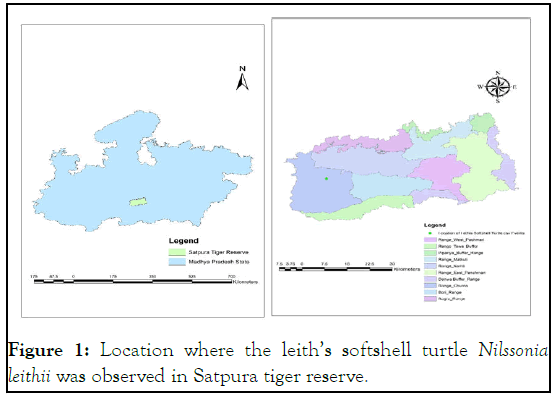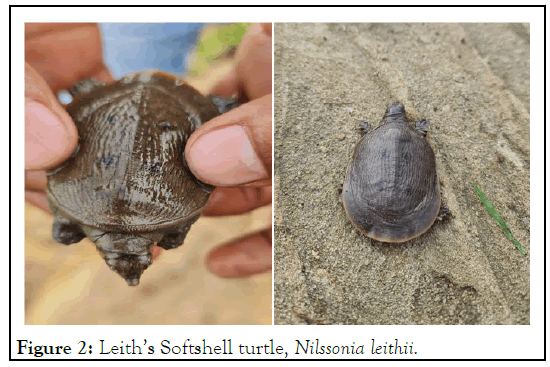Entomology, Ornithology & Herpetology: Current Research
Open Access
ISSN: 2161-0983
ISSN: 2161-0983
Mini Review - (2023)Volume 12, Issue 3
Leith’s Softshell Turtle, Nilssonia leithii (Family Trionychidae), is a large turtle, known to attain at least 720 mm in carapace length (bony disk plus fibrocartilage flap), and possibly as much as 1000 mm. The species inhabits the rivers and reservoirs of southern peninsular India, replacing the more familiar Indian softshell Turtle, Nilssonia gangetica, of Northern India. The turtle is apparently rare within its range, even within protected areas, which is suspected to be due to a past history of exploitation. Fish, crabs, freshwater molluscs, and mosquito larvae are taken as food, and some numbers are kept in temple tanks, where they are often fed on Hibiscus flowers. At least two clutches of eggs, which are spherical, are suspected to be produced per year. Distribution–India. Restricted to southern peninsular India (Andhra Pradesh, Karnataka, Kerala, Madhya Pradesh, Maharashtra, Orissa, and Tamil Nadu) in the Cauvery, Thungabhadra, Ghataprabha, Bhavani, Godavari, and Moyar drainages.
Nilssonia leithii; Ocelii; Morphometry; Genetic analysis; Taxonomy
Taxonomy
Originally described as Trionyx leithii by gray. The trionychid turtles (Testudines: Trionychidae) in Indian subcontinent are represented by five genera, namely, Lissemys, Pelochelys, Chitra, Dogania and Trionyx (currently aspideretes). Two species of trionychid turtles, the leith’s softshell turtle (Aspideretes leithi) and Asian giant softshell turtle Pelochelys cantorii were collected from Bharathapuzha, the longest river in Kerala state. Praschag, et al., based on genetic analysis, included this species in the genus Nilssonia. Liebing, et al., showed that N. leithii shares a sister relationship with Nilssonia gangetica. No subspecies have been described and geographic variation, if any, has at present not been reported. Valid synonyms include Trionyx sulcifrons annandale from Nagpur, West-central India. Gemel and Praschag listed synonymies as relevant to this taxon.
Nonetheless, at least two distinct morphotypes from peninsular India are currently allocated to this species [1].
Morphology
The color of the turtle including the carapace was olive green, with five ocelli, which were black surrounded by red, with a black outer border. The ocelli were arranged in such a way that three were in front (towards the head) and two were towards the rear region. The neck was, however, reddish and the plastron cream colored. Several longitudinal rows of tubercles were also present on the carapace. The leith's softshell turtle is also characterized by an elongated snout.
The ocelii or the eye like markings is typical of the juvenile individuals. The measurements of the specimen also indicate that it is a juvenile individual. The morphometric measurements of the specimen were carapace 52 mm, plastron 39 mm and tail 11 mm. The length of the adult is 508 mm [2].
The carapace is low and oval; a preneural with one or two neurals separates the first pair of pleural bones; the eighth pair of pleurals meets each other at the carapace midline; there are eight or nine neurals; the triturating surfaces of the maxilla are flat with a prominent median groove. A patch of flat, wart like tubercles is often present on the anterior median edge of the carapace and along the midline posterior to the bony portion of the shell in some populations, while absent from others. Whether this has any taxonomic significance is not known. The carapace is gray or grayish olive with yellow vermiculations, most prominent in the young, which possess 4-6 dark centered, light bordered eye like spots. The plastron is cream colored. The head is greenish, sometimes with a black streak (especially in juveniles) that extends from the eye to the neck; two or three pairs of dark lines extend toward the side of the head and another extends backwards from the eye. The corner of the mouth has a yellow or reddish orange spot and patches of the same color are present on the forehead of juveniles. The outer surface of the limbs is olive, the inner surface cream colored. Secondary sexual dimorphism is known, with males showing comparatively longer and thicker tails than females [3]. The mean (curved) carapace length (bony disk plus fibrocartilage flap) of an adult male from the same area had a (curved) carapace length of 720 mm.
Distribution
Leith’s Softshell Turtle is endemic to peninsular India, and occurs in rivers and reservoirs. The early records of this species from a few northern Indian drainages are considered erroneous. The Leith's Softshell Turtle was first reported from Kerala only in 1997 by Thomas, et al., from river Chaliyar in Nilambur, Malappuram district. Easa and Ramachandran later reported the species from Chalakudy in Thrissur district, also. Outside Kerala Aspideretes leithii occurs in the Bhavani, Godavari, and Moyar rivers of peninsular India. Its diet is mostly made up of worms, snails, prawns, crabs, fish, tadpoles, but also some plant material. This turtle is endemic to peninsular India gives the occurrence of the species in Madhya Pradesh, Maharashtra, Karnataka, Andhra Pradesh and Tamil Nadu [4].
New site recorded
Before there are no evidences of this species in Satpura tiger reserve. On 30th June 2020 we have got a new location in Suplai beat of Churna range in Satpura tiger reserve. GPS location is 22°27'45.1"N 78°01'13.4"E.
We observed this species for 10 min and after that we released it into the same location. The observed species found male (Figure 1).

Figure 1: Location where the leith’s softshell turtle Nilssonia leithii was observed in Satpura tiger reserve.
Population status
Few data are available of the population status of this species, the turtle not being common anywhere, even within protected areas, such as the mudumalai wildlife sanctuary, Tamil Nadu, Southwestern India, presumably because of hunting for the trade in calipee and habitat destruction. Nonetheless, viable populations appear to remain in the Thungabadra river, Kali river, Bheema river (around the Krishna river tributaries, except the Malaprabha river). A month long sampling effort on two separate occasions in 2012 and 2013 in the Kali river yielded 4 (sex ratio: 2.2) and 2 (sex ratio: 1.1) individuals, respectively.
Habitat and ecology
The species appears to replace N. gangetica in peninsular India, although there are unsubstantiated reports of the species from the north, including the state of Gujarat, where both species reportedly occur sympatrically. Generally, records of the species are from large, east and west flowing rivers that arise from the low hills of Peninsular India, with isolated records from large reservoirs. An individual was recently recorded from Perinjanam, Thrissur district, Kerala, at the mouth of the Chalakudy River, suggestive of its occasional usage of estuarine habitats. Nilssonia leithii is known to consume fish, crabs, freshwater molluscs, and mosquito larvae (Figure 2) [5].

Figure 2: Leith’s Softshell turtle, Nilssonia leithii.
Fishermen along the Kali river report that the species often retrieves fish trapped in monofilament gill nets. Two specimens were dug up from mud in the bed of a pool just after the winter months (dry part of the year) in the Nallamala hills of the Eastern Ghats. Annandale, suggesting that the species may estivate during the summers. Some specimens of N. leithii are kept in a temple tank at Kotapalli village, Andhra Pradesh, Southeastern India, where they are fed on flowers of the red China rose (Hibiscus rosa-sinensis) and banana (Musa domestica). Little is known of the reproductive behavior of the species. In mid-June, a female was found to carry fully developed, shelled eggs with a diameter of 31 mm. Oviductal eggs, ready for oviposition, were also found in the month of January, suggesting that at least two clutches may be laid in a year, and fishermen along the Kali River reported that nesting occurs in the months of December and January. Two hatchlings were observed in the Moyar River, near Tengumarahada village on 15 July 1994, and eggs found in Pune, Maharashtra, West central India, were spherical and 29.8 mm–31.1 mm in diameter. Nesting in the Sharavathi Valley Wildlife Sanctuary reportedly occurs between the months of April and May. The intestinal parasite, Astiotrema cirricurvatus, has been recorded from this species [6].
Threats: The species has been subject to intensive exploitation over the past 30 years. It has been poached and illegally consumed within India. It has also been illegally traded abroad for meat and for its calipee. The population of this turtle species is estimated to have declined by 90% over the past 30 years such that the species is now difficult to find.
India’s proposal for transferring Leith’s Softshell Turtle (Nilssonia leithi) from Appendix II to Appendix I of the Convention on International Trade in Endangered Species of wild fauna and flora (CITES) has been adopted by the Conference of Parties (CoP) to CITES in its 19th meeting at Panama. The Leith’s Softshell Turtle (Nilssonia leithii) is considered as rare and cryptic species even its status information is scarcely available consequently very few conservation initiatives are taken to save the species in most of its distribution ranges. We observed this species during monsoon patrolling. We need to further study to confirm its population size and the distribution in the Satpura Tiger Reserve.
We are thankful to CWLW, MP and field director Satpura tiger reserve for their support. We also thankful to assistant director, Bori Sanctuary, range officer Churna and field staff Churna to discover this species.
Citation: Fellows S, Saha S (2023) First Record of Leith's Softshell Turtle (Nilssonia leithii) in Satpura Tiger Reserve, Narmadapuram, MP. Entomol Ornithol Herpetol. 12:307.
Received: 08-May-2023, Manuscript No. EOHCR-22-20514; Editor assigned: 10-May-2023, Pre QC No. EOHCR-22-20514 (PQ); Reviewed: 24-May-2023, QC No. EOHCR-22-20514; Revised: 31-May-2023, Manuscript No. EOHCR-22-20514 (R); Published: 07-Jun-2023 , DOI: 10.35248/2161-0983.23.12.307
Copyright: © 2023 Fellows S, et al. This is an open-access article distributed under the terms of the Creative Commons Attribution License, which permits unrestricted use, distribution, and reproduction in any medium, provided the original author and source are credited.